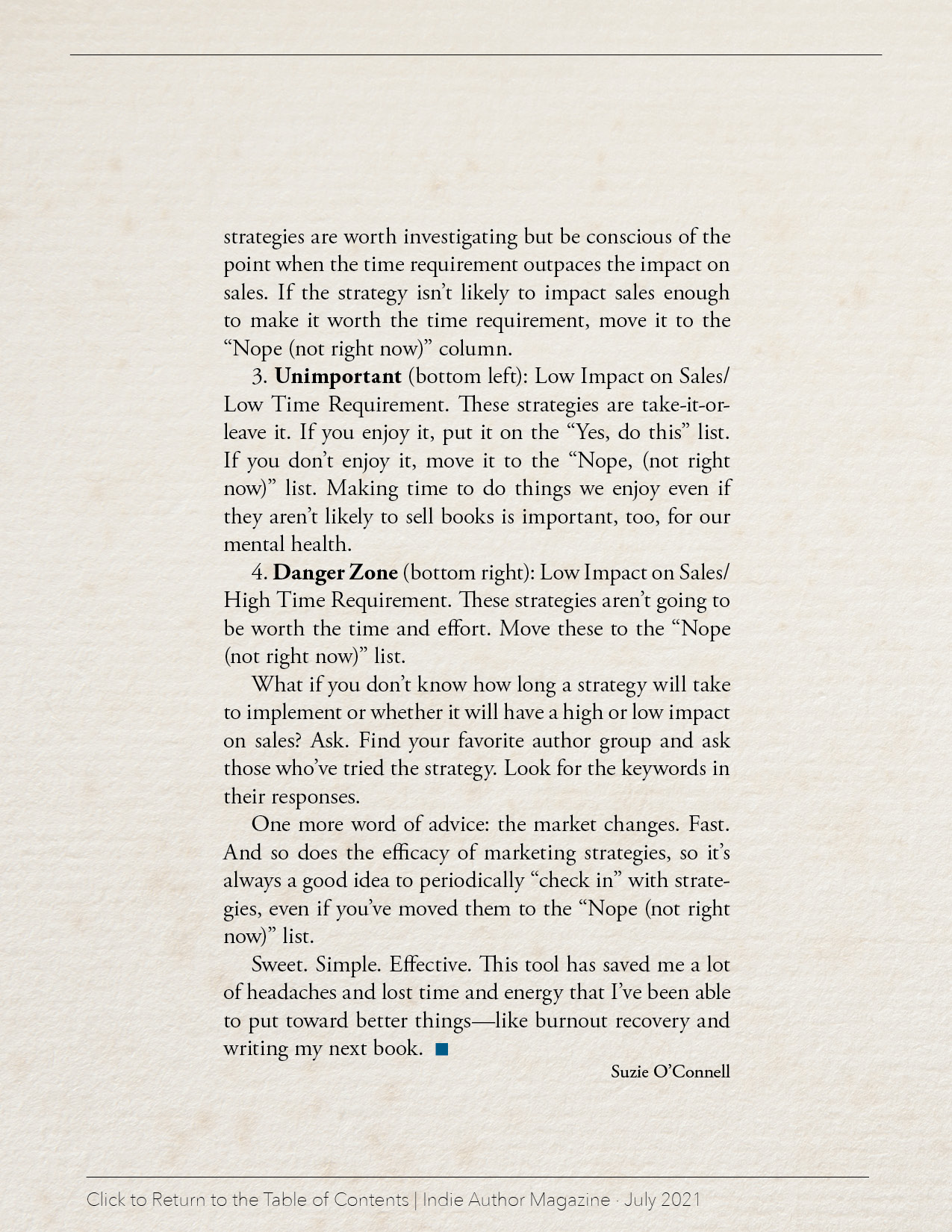Prioritize Your Strategies for a Healthier, Happier Author Life
Ah, the Fear of Missing Out (a.k.a. FOMO). That nagging panic that tricks us into thinking if we don’t try the newest, flashiest marketing strategy populating our news feeds, our author business will wither. It is distracting at best. At worst, it can plunge the unsuspecting author into burnout… And a lot of authors who burn out don’t come back from it. Let’s make sure that doesn’t happen to you.
Yes, I’ve been there, done that, got the T-shirt. I tried to chase the trends, to do it all, looking for that magic bullet (spoiler alert: there is no magic bullet), and I ran my well so dry it’s taken me three years to refill it. The words simply vanished. The stories fell silent. But as I’ve worked on building healthy habits and mindsets, I’ve learned how to question each new shiny that comes into my sphere of awareness.
I use a tool adapted from the Eisenhower Matrix. It’s a simple two-by-two grid, and here’s how I label it:
- Top row: High Impact on Sales (This strategy is likely to sell the most books.)
- Bottom row: Low Impact on Sales (This strategy is likely to sell only a few books.)
- Left column: Low Time Requirement (This strategy will take little time to implement.)
- Right column: High Time Requirement (This strategy is going to take a lot of time to implement.)
Now it’s just a matter of looking at the prospective marketing strategy and asking “Will this have a high or low impact on sales? Will it have a high or low impact time requirement?” and seeing which cell it lands in:
1. Sweet Spot (top left): High Impact on Sales/Low Time Requirement. These strategies are going to be your bread and butter—this is where your best ROI will come from. Move these to the “Yes, do this” list.
2. Important (top right): High Impact on Sales/High Time Requirement. These strategies are worth investigating but be conscious of the point when the time requirement outpaces the impact on sales. If the strategy isn’t likely to impact sales enough to make it worth the time requirement, move it to the “Nope (not right now)” column.
3. Unimportant (bottom left): Low Impact on Sales/Low Time Requirement. These strategies are take-it-or-leave it. If you enjoy it, put it on the “Yes, do this” list. If you don’t enjoy it, move it to the “Nope, (not right now)” list. Making time to do things we enjoy even if they aren’t likely to sell books is important, too, for our mental health.
4. Danger Zone (bottom right): Low Impact on Sales/High Time Requirement. These strategies aren’t going to be worth the time and effort. Move these to the “Nope (not right now)” list.
What if you don’t know how long a strategy will take to implement or whether it will have a high or low impact on sales? Ask. Find your favorite author group and ask those who’ve tried the strategy. Look for the keywords in their responses.
One more word of advice: the market changes. Fast. And so does the efficacy of marketing strategies, so it’s always a good idea to periodically “check in” with strategies, even if you’ve moved them to the “Nope (not right now)” list.
Sweet. Simple. Effective. This tool has saved me a lot of headaches and lost time and energy that I’ve been able to put toward better things—like burnout recovery and writing my next book.



